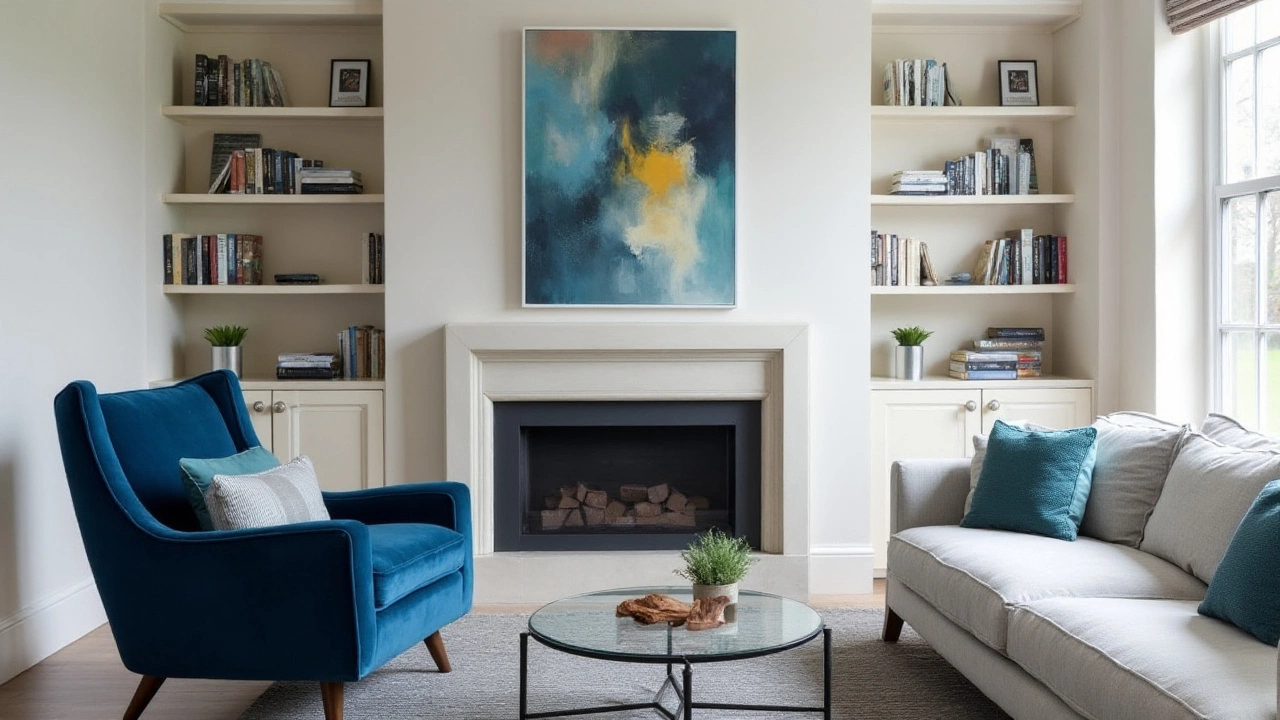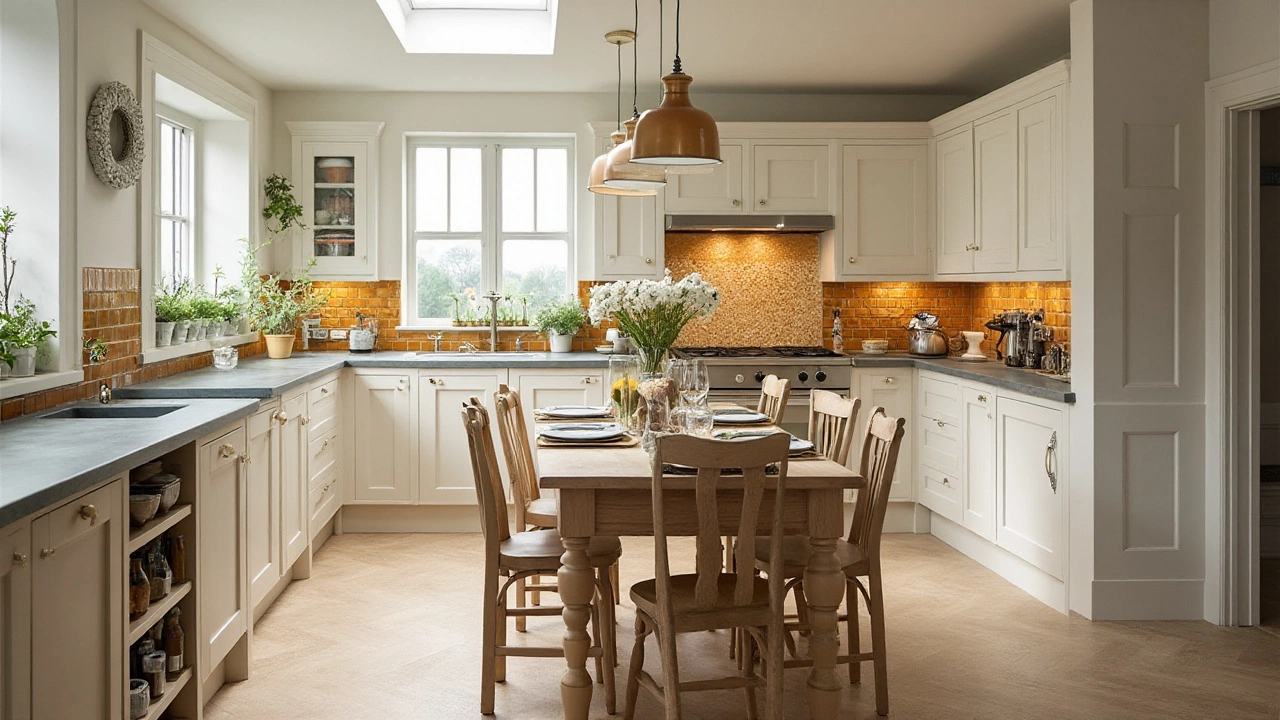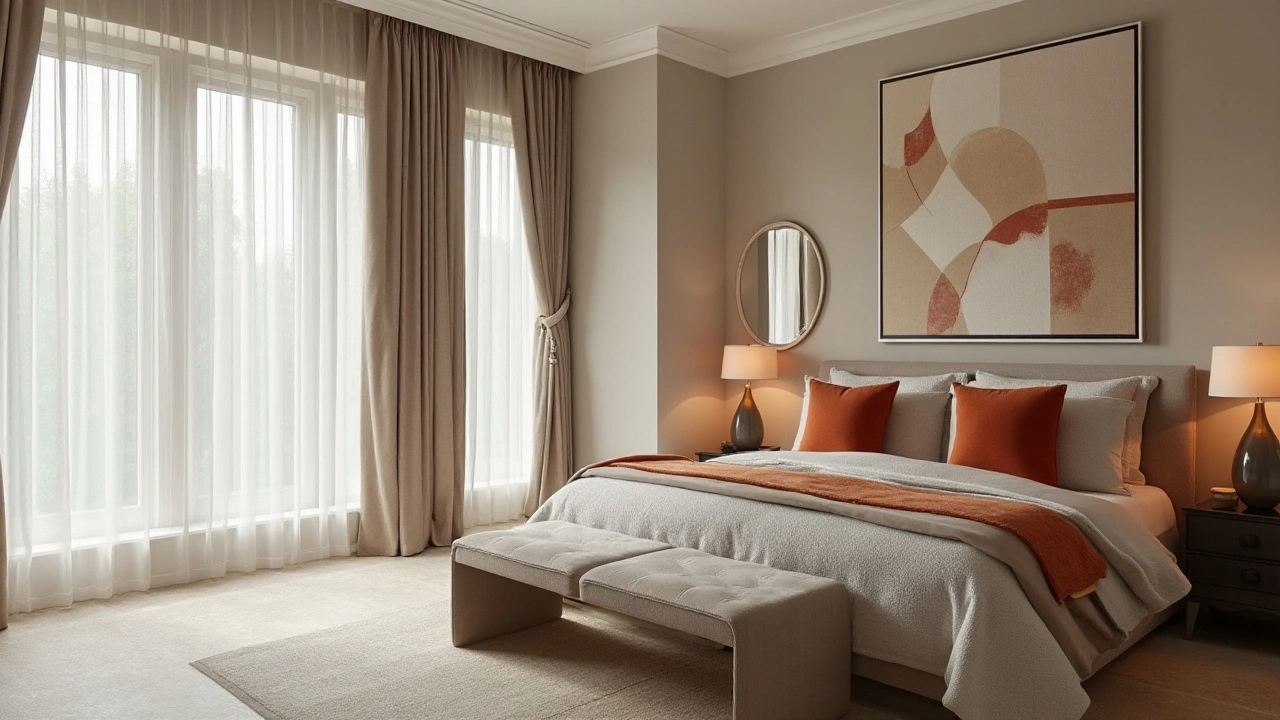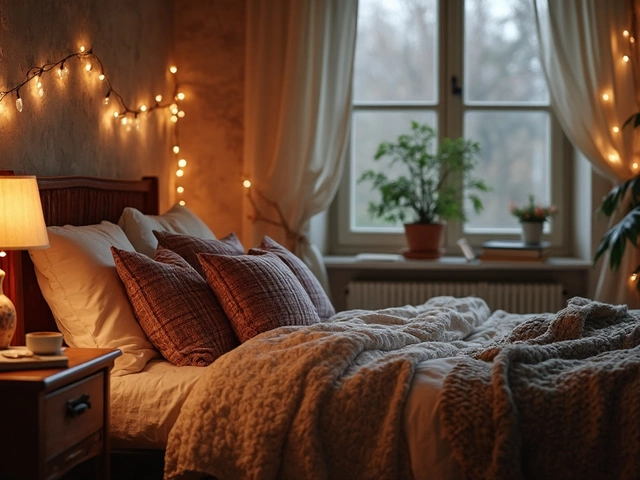
In the realm of interior design, there's a smart little strategy known as the 80/20 rule that has been quietly revolutionizing the way spaces are curated. This principle isn't just some trendy buzzword; it’s a tool that helps create balanced and inviting rooms, offering a seamless way to mix subtlety with flair. One might think of it as the unsung hero of design principles, quietly orchestrating the harmony of a room.
The essence of the 80/20 rule lies in its simple approach: ensure that 80% of your space remains a calm canvas, allowing the remaining 20% to burst forth with character and vibrancy. It’s not about stifling creativity but about channeling it effectively to make both style and comfort a priority. Whether you're diving into a major home redesign or just tweaking a room here and there, this rule can guide you toward achieving that magazine-worthy look you’ve been dreaming about.
- Understanding the 80/20 Rule in Design
- Creating Balance with the Rule
- Choosing Your 20% Accent Pieces
- Common Mistakes to Avoid
- Practical Examples and Tips
Understanding the 80/20 Rule in Design
The 80/20 rule, or Pareto Principle, is a fascinating concept known to make waves across various fields, and interior design is no exception. Born out of an economic principle developed by Vilfredo Pareto in 1896, it suggests that roughly 80% of the effects come from 20% of the causes. How does this apply to decorating your living spaces, you might ask? The answer lies in its simplicity and elegance. In the realm of design, this principle suggests dedicating 80% of your space to neutral, calming elements while the whimsical or bold aspects – occupying the remaining 20% – serve as the wow factor.
One might wonder why this specific division? Well, decorating often means a dance between order and chaos, and finding the right balance is key. Much like a symphony, where most of the orchestra contributes to a harmonious base while only a few instruments steal the spotlight at any given time, design seeks to balance subtle beauty with standout features. This technique doesn’t stifle creativity but channels it in a way that amplifies impact, using the decorating tips drawn from this principle to make each room not just beautiful, but also functional and inviting.
Imagine stepping into a living room where the walls, furniture, and large components are in subdued hues, creating a serene canvas. In contrast, a vivid piece of modern art or a striking rug makes a bold statement, drawing the eye to the strategic placements that command attention. This is the essence of the 80/20 rule in action. Such an approach not only keeps the space from feeling overwhelming but ensures that the standout pieces are precisely that – standouts. The practice isn't about following strict numbers but understanding the psychological echo that such balance brings to a human eye. As the renowned designer Nate Berkus said,
"Your home should tell the story of who you are, and be a collection of what you love brought together under one roof."
Moreover, the impacts of this rule are quantifiable. A well-decorated space can enhance mood, influence productivity, and even affect perception. According to a study conducted by The University of Minnesota, environments that incorporate vibrant, yet balanced design elements are proven to boost creativity and increase mental well-being, a testament to the subconscious influence of design on our daily lives. So, when decorating, keep in mind the understated power of balance — it’s not just about the visual impact but how a well-thought-out space makes you feel.
This design philosophy isn't rigid; instead, it invites flexibility and personalization. Every homeowner can adapt it to suit their personal taste, going bolder with colors in the 20% or playing it more subtly. The important thing is understanding that this guideline can be a tool in your design toolkit. Whether working with a sprawling open-plan or a cozy nook, the 80/20 rule offers a compass to navigate the aesthetics of your home with poise and precision.
Creating Balance with the Rule
Achieving balance in interior design can often feel like walking a tightrope. On one hand, you want a room that feels peaceful and unified, while on the other, there's a desire to inject personal flair and character. This is where the 80/20 rule becomes the unsung savior. By designating 80% of your space to neutral elements such as whites, beiges, or grays, the room retains a sense of tranquility and spaciousness. These colors act as a calming backdrop, allowing natural light to bounce around the room, making it feel larger and inviting. Meanwhile, the remaining 20% can be filled with more striking colors or bold patterns—we're talking a pops of electric blue or a burst of fiery orange in your accents. This rule allows the brighter or more dramatic elements to shine without overwhelming the senses, creating an overall aesthetic harmony that is both stimulating and soothing.
Let's delve a little deeper. The key to creating this balance lies in understanding the psychological impact of colors and patterns. Neutrals aren't just safe choices—they bring a serenity and timelessness to a space. They act as the skeleton, the foundational structure upon which decorative elements rest. But those bits of vibrancy, the colorful artwork, the playful throw pillows, and textured rugs—these are your chance to tell a story, evoke a mood. A beautiful painting with hints of red or a golden vase can imbue warmth and richness in the colder months, whereas, during summer, vibrant greens and oceanic blues can engender a refreshing coolness. Emphasizing the 20% doesn't just pepper a room with style; it coordinates those small details that speak volumes. As an example, noted designer Nate Berkus once said,
"Your home should tell the story of who you are, and be a collection of what you love."The 80/20 rule provides a framework for your story, allowing both the canvas and the paint to shine in harmony.
Function also plays an essential role here. The 80/20 rule naturally encourages the delineation of functional areas within a room. Imagine a living room where 80% of the space is dedicated to functional furniture like sofas and bookshelves in neutral tones, leaving the remaining 20% for experimenting with texture and pattern through accent chairs or an exotic tapestry. This balance not only enriches aesthetics but boosts practicality since the core design remains intact and easy to update with changing tastes or seasons. Working within these parameters offers a dynamic yet orderly approach to decorating that feels refreshingly effortless.
But let's not forget: balance is not synonymous with symmetry. Rooms don't need to be perfectly symmetrical to feel balanced. In fact, too much uniformity can feel stark or even uninviting. Creating balance is about juxtaposition—the calming whites against the lively blues, the heavy textures of a rug against the sleek finishes of modern furniture. It becomes an art form that allows spaces to evolve organically while remaining anchored in a cohesive design philosophy. Embracing this dynamic interplay not only frees up creativity but also encourages personal expression within a structured format.
In the end, it's about listening to what a space wants to say and allowing it to speak in your voice. Let this rule guide you, not confine you. Amid the possibilities, remember to enjoy the process of blending function with style, simplicity with boldness. As spaces transform, drawing inspiration from the 80/20 rule, they turn into living works of art, crafted with a keen eye toward balance and individuality. So next time you're redecorating, give this trusty rule a try and watch how effortlessly it transforms chaos into harmony.

Choosing Your 20% Accent Pieces
When implementing the 80/20 rule in interior design, picking that crucial 20% of accent pieces requires a thoughtful approach. This selected fraction of your space is what often captures attention and injects character into the room. The beauty of accent pieces is that they can range in variety and scale, from bold artworks to a splash of color on a feature wall, each one playing a pivotal role in achieving balance. Understanding the diversity of potential accent pieces can help a decorator effectively twist the narrative within any room.
Start by deciding which elements you want to stand out. It could be a vivid table lamp that catches the setting sun and dances with shadows along your wall. Or maybe a lush, oversized plant that breathes fresh life into your living space. Choosing these pieces often involves considering the room's existing color palette, ensuring the accents either complement or contrast in a pleasing way. Don't shy away from utilizing textures as accents; a velvet cushion or a thick woven rug can add layered depth to a mostly neutral setup. These choices aren't just about color, but about playing with the sensory experience of the room.
Proportionality plays a key role in picking your accent items. While it might be tempting to make every choice a bold one, restraint is crucial to prevent overwhelming the senses. A single striking piece can often be more effective than several smaller accents when trying to maintain harmony within your design. If used judiciously, strong pops of color can resonate well, without causing chaos. For instance, you could anchor the room with a decorating tips twist like a statement couch, then dot smaller vignettes of that hue throughout the space in more subtle forms, such as throws or pottery.
Sometimes, inspiration can be gleaned from existing collections or personal artifacts. Incorporating something that carries history or sentimental value as your 20% accent can add a level of depth and narrative that store-bought pieces cannot offer. Consider displaying an antique vase inherited from family or showcasing a travel find that sparks stories and conversations. Such elements not only enhance the visual focus of a room but also offer a personal touch, adding layers to the home's personality in ways conventional pieces never could.
Tips for Selecting Accent Pieces
- Assess your room's current aesthetic before choosing to ensure cohesion rather than conflict.
- Use accent pieces to either complement or contrast your existing color palette effectively.
- Consider scale and proportion to avoid cluttering the space with too many statement elements.
- Experiment with textures — they can add subtle depth without overwhelming a room.
- Opt for personal or historical items to create a unique narrative and personal connection.
Finally, remember that choosing your home decor accents is as much an art form as it is a science. As famed designer William Morris once said, "Have nothing in your house that you do not know to be useful, or believe to be beautiful."
"Have nothing in your house that you do not know to be useful, or believe to be beautiful." – William Morris
This quote serves as a reminder that while it’s fun to fill spaces with the latest trends, long-lasting appeal often results from items of timeless beauty or personal significance. With careful decorating tips and intentional selection, your accent pieces will shine brilliantly, highlighting the unique charm of your space while resonating with your style narrative.
Common Mistakes to Avoid
When applying the 80/20 rule in interior design, even seasoned designers can stumble upon certain pitfalls that might disrupt the harmony they wish to craft. One common blunder is not adhering strictly to the proportions, thus diluting the impact. It's tempting to allow more than 20% of bold elements to creep into the room, which can overwhelm the senses and lead to a cluttered appearance. Remember, the beauty of this principle lies in restraint, guiding the eye toward focal points without overwhelming. Stay disciplined about your selections, ensuring the bold 20% is defined and impactful.
Another mistake arises from the misconception that neutral elements must be white or beige, limiting the palette unnecessarily. In reality, neutrals encompass a wide spectrum, including grays, taupes, and even muted blues and greens. These shades provide a rich canvas that supports your accent pieces without being stark or uninspiring. Understanding this diversity allows for a more personalized and engaging environment, where the subtler aspects can still convey depth and warmth.
There is also a risk of falling into thematic monotony, where the 20% becomes too predictable. Consistently using the same type of accents, like the repeated color of a vase or similar art pieces, can make the intriguing features seem repetitious rather than lively. Embrace diversity within your accents, mixing textures, shapes, and even art forms. As the saying goes, variety is the spice of life, and it holds true in decorating. When you vary your accents thoughtfully, it maintains the freshness and dynamic nature of your space.
"Creativity doesn't wait for that perfect moment. It fashions its own perfect moments out of ordinary ones." — Bruce Garrabrandt
Adding to the list of potential missteps, one might find themselves underestimating the power of strategic lighting, which can transform how interior design elements are perceived. Often sidelined, lighting should be considered a part of the 80% subtle foundation. A well-lit room highlights the vibrant 20% and augments the ambiance. Avoid overlooking this aspect by incorporating various light sources: from ambient to task lighting, and of course, accent lighting can make focal points pop without expanding your bold category excessively.
Lastly, let's discuss the challenge of layout inefficiencies. Focusing too narrowly on aesthetics while neglecting functionality can make even the most visually appealing room a poor living space. Arranging furniture and decor in a way that disrupts natural traffic flow or comfort contradicts the very idea of creating a harmonious environment. Prioritize functionality alongside aesthetics to ensure the space serves its purpose and pleases the eye. With careful planning, these common snags can be navigated, leading to an effortlessly beautiful room that not only looks good but feels just right.

Practical Examples and Tips
When it comes to implementing the 80/20 rule in interior design, the results can be transformative. It's not just about cramming bright colors into a space, but creating a thoughtfully balanced composition that sparks interest. Imagine stepping into a living room swathed in calming shades of grey. The walls, sofa, and even the flooring echo serenity. Now, inject vitality: a vibrant art piece hung above the couch, a crimson vase nestled on a side table, or even a couple of mustard-yellow throw pillows. This 20% touch brings life to the room without being overwhelming.
Taking a cue from kitchens, another space where this principle can bring a striking impact, focus on cabinets, countertops, and hardware as the neutral dominators. With clean whites or soft taupes occupying the 80% backbone of your design, you could let a bold backsplash serve as the conversation starter. These splashes of color and texture create interest without creating chaos. A professional designer might say that “mixing materials and finishes gives the best results with minimal effort.” Leveraging textures, like a wooden accent for the cabinetry knobs or a splash of shiny tile behind the stove, can make an understated kitchen radiate style.
Bedrooms, sanctuaries of respite, also benefit from this strategic approach. Start with your ample 80% canvas—bedding, furniture finishes, and walls in serene tones. Then, cast an eye toward refreshing vibrancy: a patterned rug at your feet, jewel-toned curtains framing your window, or perhaps a statement light fixture that casts playful shadows at dusk. These elements act as visual punctuation, bringing character and charm while still respecting the restful atmosphere one seeks in a bedroom.
Now, one mustn’t forget the frequently overlooked bathrooms! A pristine white-on-white palette sets a clean slate visually. Yet, for that necessary grandeur, consider a dramatic floor tile design, an intricately framed mirror, or even vivid towels on display. These subtle accents adhere to the 80/20 rule while adding both depth and luxury.
To illustrate, let's say your living space's primary surfaces embrace earthy hues. Here, a stunning, emerald green armchair could serve as your captivating 20%. Paired with a gleaming gold floor lamp, this setup doesn’t just capture the eye but harmonizes with nature, inviting comfort within style. Style icons such as Nate Berkus often advocate for striking that balance: “Design is most beautiful when it finds its own unique harmony.”
Whether sticking to safe subtlety with hints of vibrant expression or boldly blending daring hues amongst milder tones, following the 80/20 rule allows you to navigate the spectrum of design with confidence. Remember, it’s about achieving balance—a natural rhythm that lets the person within the space find delight morning till dusk.




